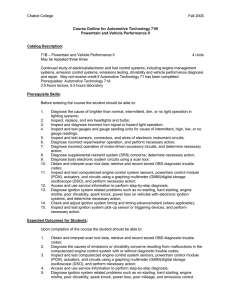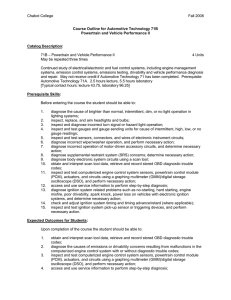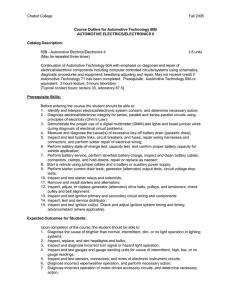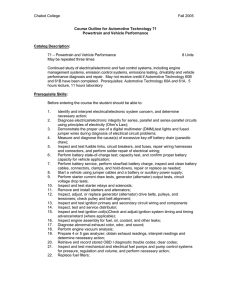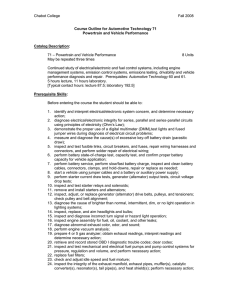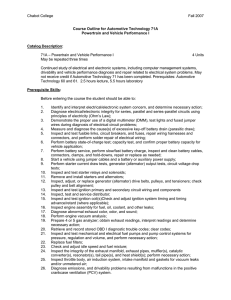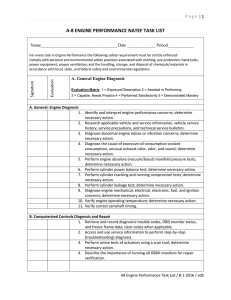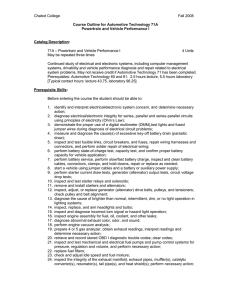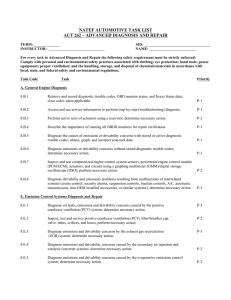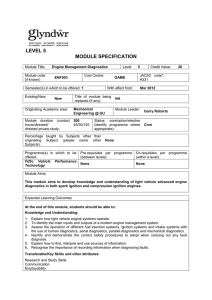Chabot College Fall 2012 Course Outline for Automotive Technology 10
advertisement
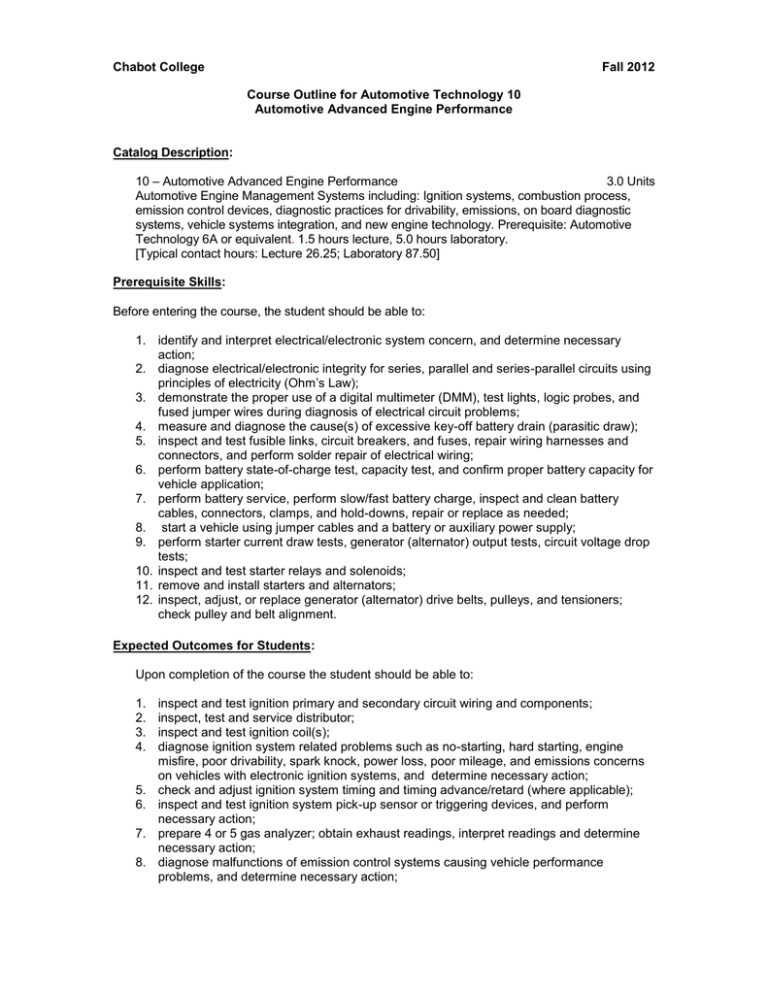
Chabot College Fall 2012 Course Outline for Automotive Technology 10 Automotive Advanced Engine Performance Catalog Description: 10 – Automotive Advanced Engine Performance 3.0 Units Automotive Engine Management Systems including: Ignition systems, combustion process, emission control devices, diagnostic practices for drivability, emissions, on board diagnostic systems, vehicle systems integration, and new engine technology. Prerequisite: Automotive Technology 6A or equivalent. 1.5 hours lecture, 5.0 hours laboratory. [Typical contact hours: Lecture 26.25; Laboratory 87.50] Prerequisite Skills: Before entering the course, the student should be able to: 1. identify and interpret electrical/electronic system concern, and determine necessary action; 2. diagnose electrical/electronic integrity for series, parallel and series-parallel circuits using principles of electricity (Ohm’s Law); 3. demonstrate the proper use of a digital multimeter (DMM), test lights, logic probes, and fused jumper wires during diagnosis of electrical circuit problems; 4. measure and diagnose the cause(s) of excessive key-off battery drain (parasitic draw); 5. inspect and test fusible links, circuit breakers, and fuses, repair wiring harnesses and connectors, and perform solder repair of electrical wiring; 6. perform battery state-of-charge test, capacity test, and confirm proper battery capacity for vehicle application; 7. perform battery service, perform slow/fast battery charge, inspect and clean battery cables, connectors, clamps, and hold-downs, repair or replace as needed; 8. start a vehicle using jumper cables and a battery or auxiliary power supply; 9. perform starter current draw tests, generator (alternator) output tests, circuit voltage drop tests; 10. inspect and test starter relays and solenoids; 11. remove and install starters and alternators; 12. inspect, adjust, or replace generator (alternator) drive belts, pulleys, and tensioners; check pulley and belt alignment. Expected Outcomes for Students: Upon completion of the course the student should be able to: 1. 2. 3. 4. 5. 6. 7. 8. inspect and test ignition primary and secondary circuit wiring and components; inspect, test and service distributor; inspect and test ignition coil(s); diagnose ignition system related problems such as no-starting, hard starting, engine misfire, poor drivability, spark knock, power loss, poor mileage, and emissions concerns on vehicles with electronic ignition systems, and determine necessary action; check and adjust ignition system timing and timing advance/retard (where applicable); inspect and test ignition system pick-up sensor or triggering devices, and perform necessary action; prepare 4 or 5 gas analyzer; obtain exhaust readings, interpret readings and determine necessary action; diagnose malfunctions of emission control systems causing vehicle performance problems, and determine necessary action; Chabot College Course Outline for Automotive Technology 10, Page 2 Fall 2012 9. use vehicle dynamometer to perform emission testing, and engine performance/drivability issues; 10. diagnose hot or cold no-starting, hard starting, poor drivability, incorrect idle speed, poor idle, flooding, hesitation, surging, engine misfire, power loss, stalling, poor mileage, dieseling, and emissions problems on vehicles with carburetion and fuel injection systems; 11. obtain and interpret scan tool data, retrieve and record stored OBD diagnostic trouble codes; 12. diagnose the causes of emissions or drivability concerns resulting from malfunctions in the computerized engine control system with or without diagnostic trouble codes; 13. inspect and test computerized engine control system sensors, powertrain control module (PCM), actuators, and circuits using a graphing multimeter (GMM)/digital storage oscilloscope (DSO), and perform necessary action; 14. access and use service information to perform step-by-step diagnosis. Course Content (Lecture) 1. 2. 3. 4. 5. 6. 7. 8. Ignition systems Combustion gasses Emission control devices Scan Tools and oscilloscopes On board diagnostics Drivability diagnosis and repair Vehicle systems integration New engine technology Course Content (Laboratory) 1. Demonstrate proper shop safety and working practices, including tools and equipment, and hazardous waste handling 2. Diagnosis, service, and repair of ignition systems 3. Combustion gas measurement and interpretation 4. Utilization of scan tools and oscilloscopes 5. Computer controlled engine management systems diagnosis utilizing scan tools 6. Diagnosis of drivability or emissions problems Methods of Presentation: 1. 2. 3. 4. 5. Lecture (utilization of multimedia) Demonstration Guest speakers Laboratory Field trips Assignments and Methods of Evaluating Student Progress: 1. Typical Assignments a. Read chapter on Principles of Ignition systems b. Complete review quiz at the end of chapter c. Complete laboratory assignments using service information, lecture materials, and text 2. Methods of Evaluating Student Progress a. Class participation Chabot College Course Outline for Automotive Technology 10, Page 3 Fall 2012 b. c. d. e. f. g. Performance on the laboratory projects Homework Quizzes Midterm exam Final examination Practical examination Textbook(s) (Typical): Automotive Fuel and Emissions Control Systems, 3rd Edition, James D. Halderman and James Linder, Prentice Hall, 2012 Special Student Materials: 1. Safety glasses 2. Shop/safety clothing KWS08282011 ATEC 10 course outline.doc
